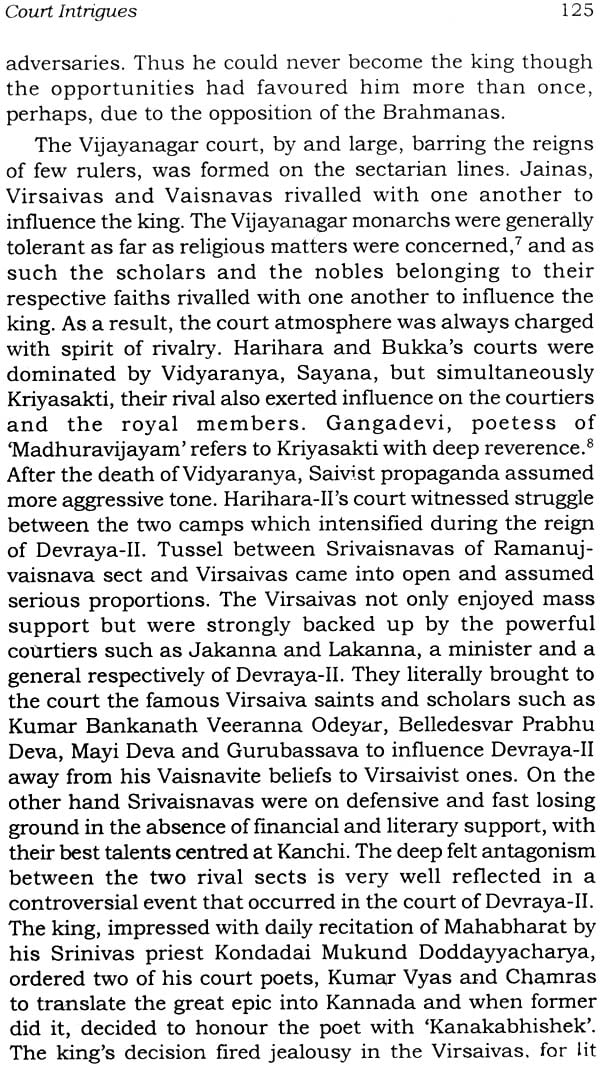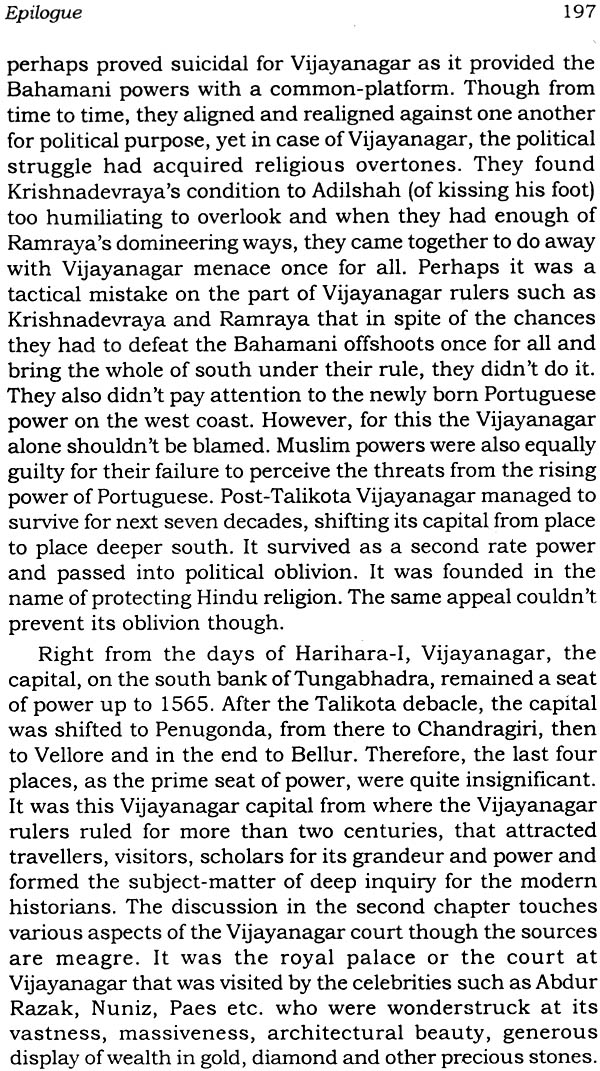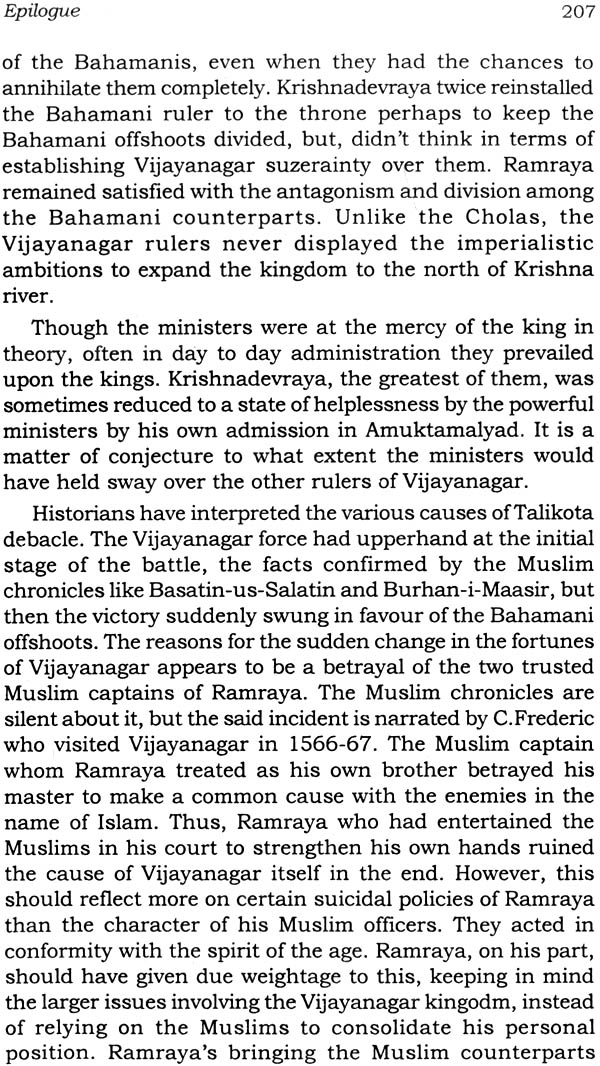
| Express Shipping: Guaranteed Dispatch in 24 hours |
|
| Item Code: | NAL256 |
| Publisher: | B.R. Publishing Corporation |
| Author: | Madhao P. Patil |
| Language: | English |
| Edition: | 1999 |
| ISBN: | 9788176460941 |
| Pages: | 228 (4 B/W Illustrations) |
| Cover: | Hardcover |
| Other Details | 9.0 inch X 6.0 inch |
| Weight | 440 gm |
In the Book Court Life Under. The Vijayanagar Rulers an effort has been made to cover the different aspects of Vijayanagar court life as Vijayanagar court dominated the scene of Indian politics and cultural life for more than three centuries. The Vijayanagar court championed unflinchingly the cause of Hinduism throughout. This book is the outcome of the author's painstaking research work based on the epigraphic sources on the subject and will be useful in particular to the researchers and students of History.
Madhao P. Patil holds a Ph.D. Degree. He is currently teaching at the Department of History,. Shivaji University, Kolhapur, Maharashtra State. His articles on history have appeared in various Indian journals.
Ever since Sewell wrote on Vijayanagar Empire as 'Forgotten Empire' in 1900, many scholars have followed him writing on the various aspects of Vijayanagar which occupies a unique position and its own place in the history of India. Sewell's pioneering work, was more or less a translation of original accounts of the travellers such as Paes, Nuniz, Barradas with occasional references to others like Razak, Conti, Varthema, etc. His book on Vijayanagar under equally attractive title 'Forgotten Empire,' further created an interest among the scholars who produced many works on Vijayanagar rendering Sewell's 'Forgotten Empire' never to be forgotten. Immediately in the year 1905, B.S. Row's book 'Never to be Forgotten Empire' arrived by way of an Indian reply to Sewell's. Before the latter wrote, it was a matter of fact that Vijayanagar had remained truly a forgotten empire. Sewell not only brought out the history of Vijayanagar but also the important source material that preserved the account of history of Vijayanagar. B.S. Row definitely used more sources than Sewell did to refute him in some of his arguments, but couldn't make his book as memorable as 'Forgotten Empire'. Subsequent writers like Saletore, Mahalingam, Venkatramanayya etc., wrote choosing variety of topics such as socio-economic aspects, like slavery arid caste system of Vijayanagar times. Father Heras worked on Arvidu dynasty of Vijayanagar when its court first at Penugonda and then at Chandragiri were regularly visited by the jesuits. Another scholar N. Venkataramanayya wrote extensively on Tuluva dynasty. 'History of Medieval India', Vols. I and II by H.K. Sherwani and Joshi and Bharatiya Vidya Bhawan's Volumes No. VI and VII edited by R.C. Muzoomdar have the independent chapters and articles on Vijayanagar. H.H. Ramsharma in his 'History of Vijayanagar Empire' concentrated more on political history. Vijayanagar Sexcentenary Commemoration Volume brought out in 1936 by Karnataka Historical Research Society, Dharwar, has variety of articles tracing arts, architecture, music, painting etc. of Vijayanagar Kingdom.
But while reading Vijayanagar history one will not fail to notice that some of the most remarkable achievements of Vijayanagar kingdom were reflected in its pomp, court grandeur, patronage, scholarly attainments etc., and the court administrative system including the court factions, disputed succession, other conditions in the court such as religion, amusement, visitors, functions of the king in the court etc., are the crucial aspects to be enquired into for understanding the inner functioning of Vijayanagar rule rather than the outer side that was exhibited by their wars and their relationship with the neighbouring states. While going through Vijayanagar history written by the scholars mentioned above it can be noticed that some important court aspects remained unattended, hence, it was considered worth while that Vijayanagar court, which remained epoch- making in every way for about three centuries in India, must be studied carefully as it made lasting contribution to art, literature, philosophy and other cultural aspects of Hindu life, in an atmosphere of hostility to all these from the neighbouring states in the South.
While studying the court life under Vijayanagar rulers, certain sources are found very useful. Nilkanth Shastri, N. Venkataramanayya and S.K. Ayangar have done yeoman service by publishing the sources of Vijayanagar history. Nilkanth Shastri published three volumes on sources of Vijayanagar thereby placing much of the necessary source material at the disposal of researchers working on Vijayanagar. Volume I deals with important historical events and general history of Vijayanagar whereas the second one is the collection of original sources. The third one gives the English translation of the original sources as 'Amuktamalyada', 'Rayavachakamu', 'Madhurvijayam', various 'Kaifiyats' etc.
The various original sources that proved useful for composing history of Vijayanagar court here can be classified as travelogue, court account and inscriptions.
Travellers' Account
Vijayanagar court was visited by a number of Persian and European travellers and envoys such as Abdur Razak, Paes, Nuniz, Barbosa, Barradas etc. Their accounts constitute very valuable contemporary source material for the study of Vijayanagar kingdom, particularly the court life. Robert Sewell, by giving English translation of original accounts of Barradas, Paes, and Nuniz in the concluding chapter of his celebrated work 'Forgotten Empire' published in 1900 has considerably facilitated the work of a researcher working on the Vijayanagar empire. Domingo Paes, who visited Vijayanagar during the reign of Krishnadevraya, wrote "of the things which I saw and contrived to learn concerning the kingdom of Narsinga", a meticulous account, that throws light on various important court aspects such as court customs, manners, the royal harem, the daily programme of the king etc. The disputed succession, contrary to the traditional Hindu law of primogeniture, characterised Vijayanagar polity. Paes' observations that the kings had some principal wives among his lawful ones and only the sons of those principal wives were the heirs of the kingdom, is very significant one so as to help understand the phenomenon of disputed succession. In this thesis, Paes has made extensive use in developing the theme of court and palace administration, court entertainment etc. In the absence of any physical identities of the Vijayanagar royal palaces except a few ruins, it is only the account of Paes that gives the minutest details about the magnificent palace of the Vijayanagar rulers there by equipping a researcher with a very fundamental aspect about the Vijayanagar court style. Barring a few errors here and there such as his description of Oriya Kingdom, Paes is authentic to a great extent and of much help to researchers exploring the court aspect of Vijayanagar.
Nuniz, a Portuguese trader, visited Vijayanagar during the reign of Achutdevmaharaya. His chronicle, written probably in 1535-37, is an important piece of historical document, that provides the account of Vijayanagar kingdom right from the circumstances leading to its foundation in 1336 to the reign of Achutdevraya. Barring a few chronological errors and a tendency to play up the importance of Portuguese, his chronicle gives valuable information about Vijayanagar, authenticity of which may be corroborated in the light of contemporary works of Ferista and some literary works produced at Vijayanagar court. Nuniz's description of Raichur expedition of Krishnadevaraya is as good as an eyewitness account. The march of Vijayanagar army, the army camp, a war between Adilshah and Krishnadevaraya are presented with minutest details. Nuniz's chronicle is used at length especially in covering Vijayanagar court intrigues and plots. Much of his chronicle is also appropriately utilised in working out the chapters on court administration, survey of history of Vijayanagar and to some extent in court entertainment.
| Preface | iii | |
| Abbreviations | xi | |
| 1 | Brief Political History of Vijayanagar Rulers | 1 |
| 2 | Court Administration | 39 |
| 3 | Court Patronage | 85 |
| 4 | Court Intrigues | 123 |
| 5 | Court Entertainment | 149 |
| 6 | Visitors and Muslim Impact | 173 |
| Epilogue | 193 | |
| Bibliography | 213 | |
| INDEX | 219 | |
| Photos |
















Send as free online greeting card
